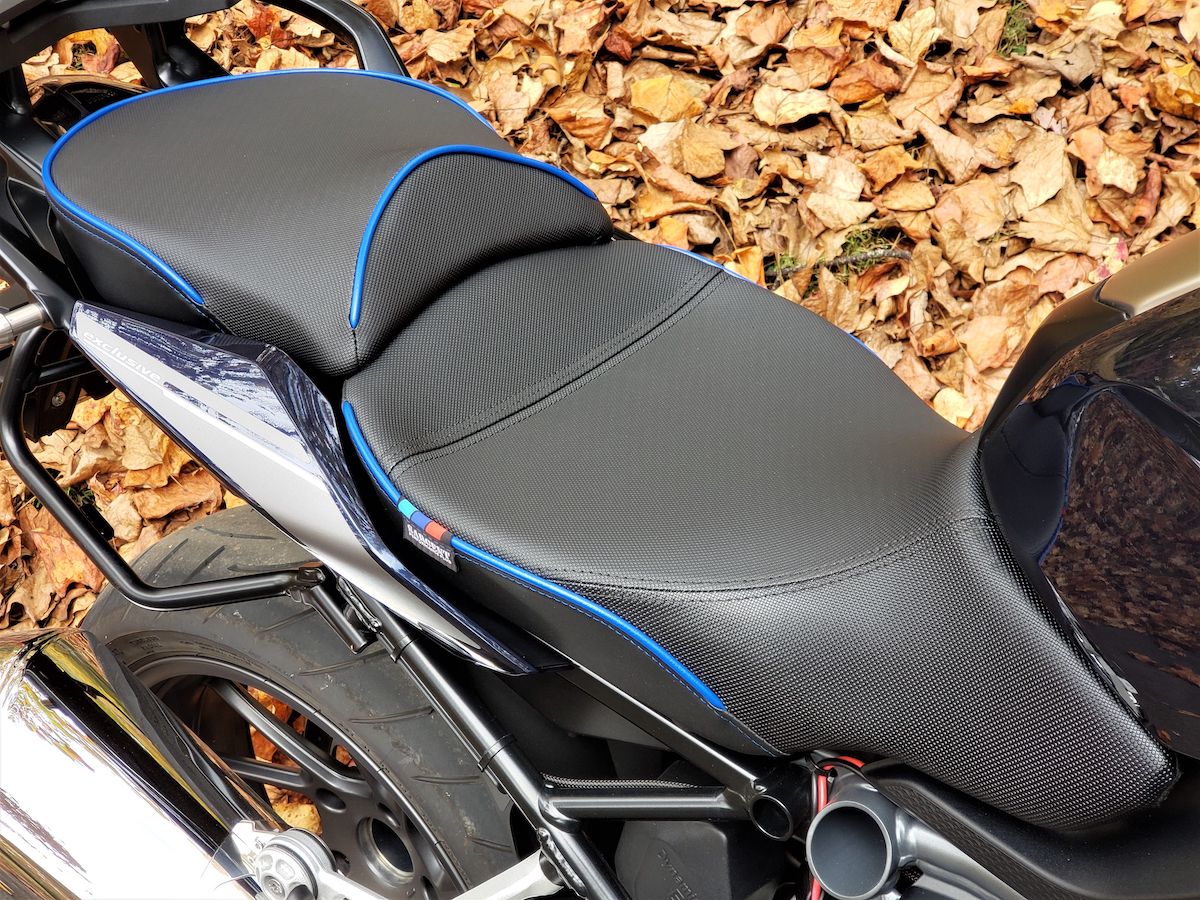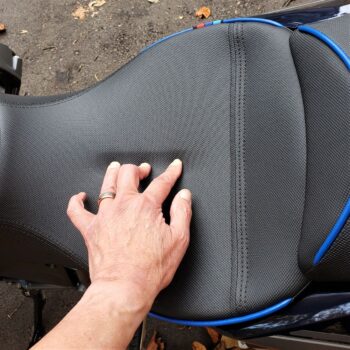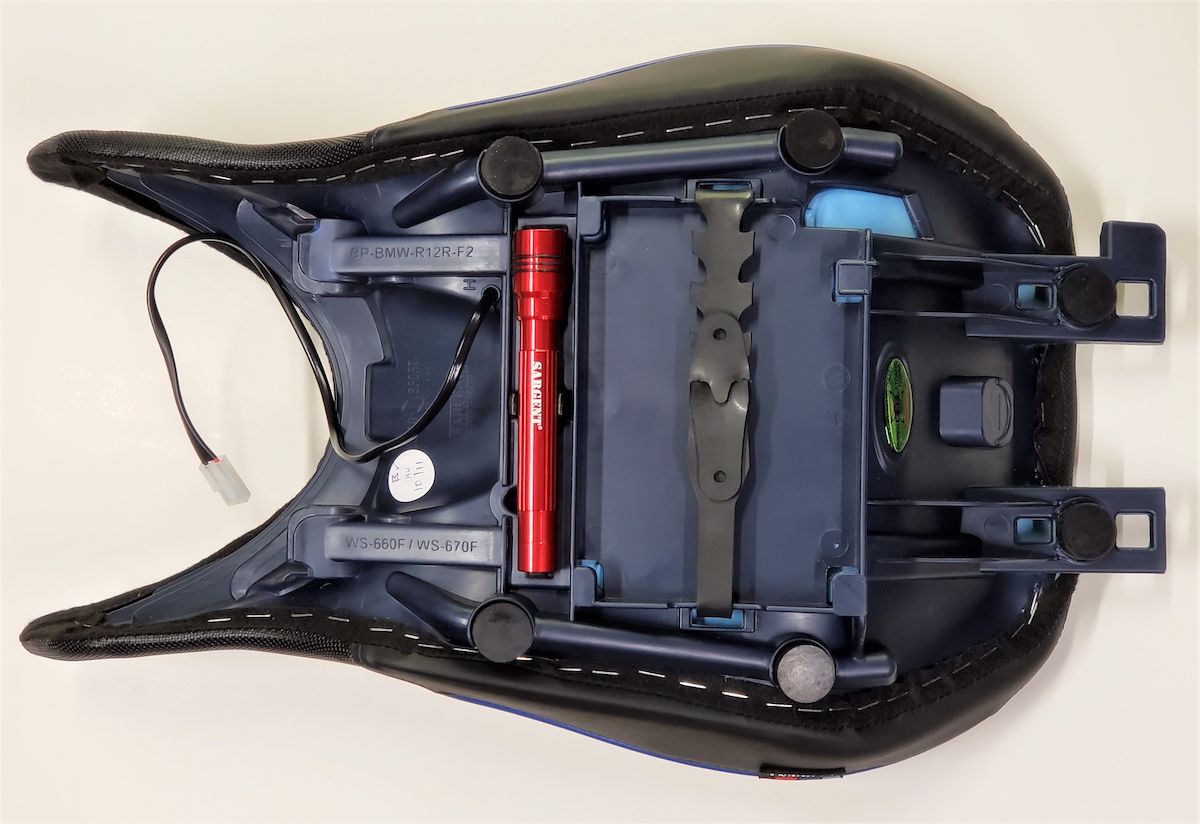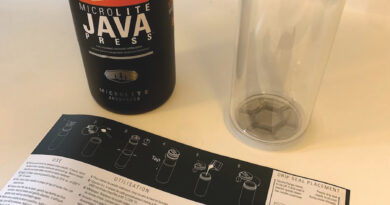Sargent heated seat – new controller & more
The above title should say, “Sargent World Sport Premium Plus Heated Seat with Matching Unheated Pillion,” but that’s a bit wordy. Sargent seats have been reviewed for MOA members before, but not the heated model, and not with its newly updated controller. You’ll probably recognize features common throughout the World Sport lineup, like the wider, flatter contours and obviously meticulous craftsmanship. Likewise, you’d expect to find the proprietary Super Cell Atomic Foam inside substantially firmer than OEM saddles, which can initially feel like a step in the wrong direction compared to a cushy stocker. Of course, that impression reverses quickly after experiencing the additional support on anything longer than the briefest of rides, with the Sargent pulling ever farther ahead as time and distance increase. At the end of a full day on the bike, there’s really no longer any comparison to be made; the Sargent seat is in an entirely different league and far superior.
Something similar happens when assessing the seat’s broader, taller (upper) edges. These can feel a bit sharp and overly wide as they press against your inner thighs the first time you stand with both feet on the ground at a stop. They also don’t allow as easy a transition to hanging one cheek off during spirited cornering, compared to a more smoothly convex perch. Depending on your inseam, which may benefit from a narrower seat at stops, and how much body English you apply in the twisties, these could be minor counterpoints to the otherwise superlative benefits of having a) more lateral lift, b) a more neutral seating angle, and c) more room to shift position during the rest of your time in the saddle. It’s a tradeoff that seems well worthwhile for the vast majority of riders during the vast majority of their riding. Also, the seat is reasonably narrow and much rounder at the front, so simply sliding forward an inch or two (which you may already do at stops and during aggressive cornering, anyway) eliminates most of the mild interference those edges might impose.

One more detail to consider regarding the dimensions of a Sargent seat is its height. On my 2020 R 1250 RS, the OEM standard saddle has a seat height of 31.1 inches; the low version is 29.9 inches tall, and the high version is 32.3 inches off the ground. Sargent’s standard seat is 30.8 inches high, slightly lower than the stocker, mainly because it’s dished instead of domed. The upper surface of Sargent’s tall version reaches an altitude of 32.4 inches. These measurements will differ from one motorcycle model to another, and Sargent offers a low version for some. Check their website to see the choices available for your specific bike. Some of Sargent’s heated seats feature plug-n-play wiring for motorcycles with an OEM heated seat option.

Those familiar with Sargent’s popular World Sport seats should note the following upgrades characterizing the Performance Plus series (with or without heating). While UV-stabilized vinyl is still used, the top surface pattern differs, with the standard World Sport’s “CarbonFX” (slick carbon-fiber weave appearance) replaced by “DTX,” which has less sheen and supplies a bit more grip. Performance Plus seats also get “Grip Zones,” which are even grippier than the DTX panels, and are located strategically where your inner thighs contact the seat in the riding position. Whether you’re squeezing there during hard braking or bracing there with your outside leg while hanging off in a corner, the additional traction and tactile feel is a noticeable advantage. Finally, whereas contrasting welt colors cost a little more on the standard World Sports, seats of the Performance Plus persuasion come with your choice of welt color (with accent stitching) at no extra charge. Sargent seals all seams for watertight construction on both product lines.
 All World Sport seats feature Sargent’s patented Zone Suspension Body Contour Technology, which includes the aforementioned Atomic Foam and two additional elements you can’t see and won’t immediately notice (they’re on both the rider’s seat and pillion). First, there’s a central longitudinal cutout like you find on technically advanced bicycle seats. This channel relieves pressure on the perineum, aiding comfort and avoiding potentially negative health impacts for male riders; you can reveal its presence by pressing along the middle of the seat with your fingertips, but otherwise it’s invisible. Second, a thin visco-layer of softer foam lies beneath the areas where pressure points are apt to develop under your sit bones, those relatively sharp protrusions of the pelvis that bear your weight in the seated position. This special layer helps distribute pressure more evenly during extended rides, reducing the likelihood of painful “hot spots,” and it’s integrated with the main foam element sans seams or glue joints. Sargent touts their all-foam design as superior to using gel inserts, which can add weight and retain unwanted heat.
All World Sport seats feature Sargent’s patented Zone Suspension Body Contour Technology, which includes the aforementioned Atomic Foam and two additional elements you can’t see and won’t immediately notice (they’re on both the rider’s seat and pillion). First, there’s a central longitudinal cutout like you find on technically advanced bicycle seats. This channel relieves pressure on the perineum, aiding comfort and avoiding potentially negative health impacts for male riders; you can reveal its presence by pressing along the middle of the seat with your fingertips, but otherwise it’s invisible. Second, a thin visco-layer of softer foam lies beneath the areas where pressure points are apt to develop under your sit bones, those relatively sharp protrusions of the pelvis that bear your weight in the seated position. This special layer helps distribute pressure more evenly during extended rides, reducing the likelihood of painful “hot spots,” and it’s integrated with the main foam element sans seams or glue joints. Sargent touts their all-foam design as superior to using gel inserts, which can add weight and retain unwanted heat.
Sargent seats are built on PolyTec base pans that interface with your bike exactly like the OEM units. In the case of BMW replacements, storage for your owner’s manual and factory-supplied tools is preserved, and an added space holds a handy aluminum LED flashlight included as a bonus – nice! As with every other Sargent seat I’ve owned over the years, the rider and passenger portions fit perfectly on my bike. A generously portioned cable extends from the base of the rider’s seat for connecting the heat-related wiring, which has an additional plug for warming the pillion if you opt to have heating elements installed there, too (such a setup would include a second controller, as well). It’s very easy to unplug and re-plug this connector when removing and replacing the rider’s seat.

The wiring harness is standard fare for an ignition-switched accessory (you’ll want to protect your battery from drainage in case you forget to turn the seat heat all the way off at the controller). Power and ground ring terminals connect to your battery posts (or remote battery attachment point) and a relay’s trigger wire gets spliced into an ignition-switched circuit, like the one for your brake light, using the included clip-on connector (no cutting, stripping, or soldering required). Then it’s just a matter of plugging in the seat and controller, with the latter mounted wherever you like using an adhesive-backed Velcro pad (handlebar or mirror-mount brackets are available for $35). There’s very little real estate around the dash of the RS, but absolutely zero room on its cast handlebars, and its mirrors mount on the fairing, not the bars, so I couldn’t use the optional bracketry. I chose a flat mounting spot where I could easily reach the controller’s dial and check its LED with a tilt of my head, although it’s mostly hidden from my view while riding (no loss, as its blocky shape doesn’t exactly complement the bike’s swoopy aesthetics). This updated controller is “back to the future,” in that it’s externally similar to a design Sargent used in the past. That one was replaced with the most recent version, which was sleeker with buttons and bar-graph displays. I tested an early-release prototype of the new controller, which should be widely available around the start of 2023.
 The “Heat Boss” controller you see here promises simplified operation and bulletproof durability. Just rotate the knob clockwise for more heat and counter-clockwise for less – and ultimately to turn it off. Instead of the usual two- or three-step settings for on-board heating, Sargent’s Heat Boss offers a much more variable arrangement. Upon startup, the LED emits a double flash to indicate the system is in Boost Mode. This supplies the heating elements with maximum power to get warmth to your posterior ASAP regardless of dial setting and lasts 15 minutes unless you move the dial in either direction sooner. After Boost Mode ends, Standard Heat Mode provides modulated power to the heating elements according to the knob position and corresponding LED flash rate. The Heat Boss is waterproof with an IP67 rating, 20V tolerant, and protected against 24V transient current/voltage spikes and polarity reversal. At full power, the single rider’s seat draws 1.7A (or 23 watts @ 13.5V); dual seat installations will double those numbers. The wiring harness power lead includes a 7.5A inline blade-type fuse. Flexible thin-film heating elements are molded into the foam just below the surface and employ Fine Wire Spiral Wound Glass Core Technology; they cannot be detected by hunting for them with your fingertips.
The “Heat Boss” controller you see here promises simplified operation and bulletproof durability. Just rotate the knob clockwise for more heat and counter-clockwise for less – and ultimately to turn it off. Instead of the usual two- or three-step settings for on-board heating, Sargent’s Heat Boss offers a much more variable arrangement. Upon startup, the LED emits a double flash to indicate the system is in Boost Mode. This supplies the heating elements with maximum power to get warmth to your posterior ASAP regardless of dial setting and lasts 15 minutes unless you move the dial in either direction sooner. After Boost Mode ends, Standard Heat Mode provides modulated power to the heating elements according to the knob position and corresponding LED flash rate. The Heat Boss is waterproof with an IP67 rating, 20V tolerant, and protected against 24V transient current/voltage spikes and polarity reversal. At full power, the single rider’s seat draws 1.7A (or 23 watts @ 13.5V); dual seat installations will double those numbers. The wiring harness power lead includes a 7.5A inline blade-type fuse. Flexible thin-film heating elements are molded into the foam just below the surface and employ Fine Wire Spiral Wound Glass Core Technology; they cannot be detected by hunting for them with your fingertips.
Experienced accessory installers will have noticed an omission above: I made no mention of the myriad hassles involved in threading wires through the densely packed labyrinth beneath the skin of a modern BMW. Since each model will present its own idiosyncratic frustrations, I’ll leave you to embark on that journey of discovery (and creativity!) for yourself. I will, however, let you in on something I learned. If you have a Hex ezCan II power distribution module, you may find the seat works fine using that as its electron source; mine did. You’ll need to fabricate a connector using one of the Hex ezCan II blanks on one end and an SAE plug on the other (cut one off an extra Battery Tender cable you have lying around). This eliminates the need for most of the Sargent wiring harness and bulky relay, and it avoids adding to the collection of accessory leads already attached to your battery. You can simply use your fabricated connector to attach the Heat Boss cable’s SAE plug to your Hex ezCan II (probably right there under the seat already), and then attach the seat to that same cable using its other plug. You’ll still have to route the controller’s cable from its mounting location to the seat and Hex ezCan II, but that’s much easier than situating the rest of the supplied wiring. Remember to use the Hex ezCan II’s software to set the electronic fuse for this connection at 7.5A, and make sure you’ve chosen a basic ignition-switched power channel without additional modulation programming.
 WARNING: While I had no trouble whatsoever powering my seat with a Hex ezCan II as described, I cannot guarantee you’ll have the same good fortune, and neither I nor the MOA publication you’re reading will take any responsibility for problems you encounter trying to replicate my results. I installed my seat first using the full Sargent wiring to confirm its functionality and it worked flawlessly. Sargent will stand behind their product with a 30-day money-back guarantee (on non-customized items), a two-year warranty on the vinyl cover, and five years on the foam and internal hardware – but only if you install it according to their instructions. They will not cover any consequences of incorporating a Hex ezCan II or any other power distribution accessory.
WARNING: While I had no trouble whatsoever powering my seat with a Hex ezCan II as described, I cannot guarantee you’ll have the same good fortune, and neither I nor the MOA publication you’re reading will take any responsibility for problems you encounter trying to replicate my results. I installed my seat first using the full Sargent wiring to confirm its functionality and it worked flawlessly. Sargent will stand behind their product with a 30-day money-back guarantee (on non-customized items), a two-year warranty on the vinyl cover, and five years on the foam and internal hardware – but only if you install it according to their instructions. They will not cover any consequences of incorporating a Hex ezCan II or any other power distribution accessory.
The big question is, how well do all these electrics work? Quite well, although the system does take a little while to reach full effect, even with Boost Mode in play. For example, on a recent early outing in the mid-40s with the Heat Boss knob at its maximum, I found the warmth noticeable within the first five minutes, and gradually more so over the next 10-15. I enjoyed comfortably toasty heat for another hour before gradually dialing it down from full power as the mercury rose. With ambient temps eventually in the 60s, I left the seat on at about ¼ power. It wasn’t that I really needed warmth at that point, just like I don’t need my car’s seat heater in warm weather, but in both cases it just plain feels good, like a heating pad on sore muscles! After first appreciating heated seats in a car, I couldn’t go back to heater-less automotive seats without feeling deprived. Now I’m spoiled with the motorcycle equivalent, too. Sargent’s unheated seats are well worth the money, but the upgrade price for heat is truly a bargain, and it may extend your riding season considerably.

A premium seat like this is an investment, especially with the luxury of heating. Pricing varies by fitment, but the setup you see here retails for $999.95, including the heated rider seat, unheated pillion, and all electrics. Adding heat to the pillion would bump that price up to $1,129.95. On the RS, this would be a custom option, but owners of some other motorcycles have the choice of ordering heated passenger seats “off the rack.” I specified the BMW-tri-color-emblem-adorned dark blue welt, thinking it would be similar to my bike’s “Imperial Blue Metallic” paint. The welt is actually quite a bit lighter, and I was somewhat disappointed when first looking at it in the garage. However, once I got everything out in the sun, I was very pleased to find the hue of the welt nicely matched the paint’s metalflake highlights; I think this might be even better than what I’d originally intended. Roam around on Sargent’s website to learn more about their range of accessory offerings and custom services, including installation of heating elements in seats you send them, and heating kits ($230) for DIY projects.



